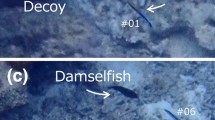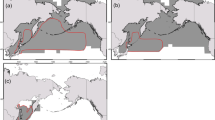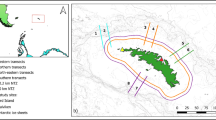Abstract
The invasive crayfish Procambarus clarkii is highly dispersed within lentic waters in northern and central Italy. It is a polytrophic predator, exerting a strong influence on animal communities, including amphibians, fish, gastropods, and insect larvae. The indigenous species Austropotamobius italicus, inhabiting lotic waters, behaves as a generalist – but not opportunistic – species. The object of this study was to compare the predatory pressure exercised by the two species on potential prey, i.e., anuran tadpoles, urodelan larvae, fish fry, larvae of insects, and gastropods. Three main conclusions were drawn: (1) both species are skilled predators, adopting a sit-and-wait strategy, (2) the two crayfish seemed to form a `search image' of familiar prey, as the result of either visual or chemical perceptual changes, and (3) at least in the laboratory, P. clarkii readily switched to naive prey for it (tadpoles of Rana italica and larvae of Limnephilidae), unlike the less opportunistic A. italicus. These results furnish suggestions on the trophic preferences of the two crayfish species and provide a partial understanding of the effects that the invasive species have on the community dynamics.
Similar content being viewed by others
References
Abrahamsson SAA (1966) Dynamics of an isolated population of the crayfish Astacus astacus. Linnè-Oikos 17: 96-107
Ackefors H (1999) The positive effects of established crayfish introductions in Europe. Crustacean Issues 11: 281-292
Avault JW Jr, Romaire RP and Miltner MR (1981) Feeds and forages for red swamp crayfish, Procambarus clarkii: 15 years research at Louisiana State University. Reviewed. Freshwater Crayfish 5: 362-369
Axelsson EP, Nyström P, Didenmark J and Brönmark C (1997) Crayfish predation on amphibian eggs and larvae. Amphibia-Reptilia 18: 217-228
Ballasina D (1984) Amphibians of Europe: A Colour Field Guide. David & Charles, London
Bertram BCR (1978) Living in groups: predators and prey. In: Krebs JR and Davies NB (eds) Behavioural Ecology. An Evolutionary Approach, pp 64-96. Blackwell Scientific Publications, Oxford
Brodie ED Jr, Formanowicz DR Jr and Brodie ED III (1978) The development of noxiousness of Bufo americanus tadpoles to aquatic insect predators. Herpetologica 34: 302-306
Charlebois PM and Lamberti GA (1996) Invading crayfish grazing in Michigan stream: direct and indirect effects on periphyton and macroinvertebrates. Journal of the North American Benthological Society 15: 551-563
Corbett K (1989) Conservation of European Reptiles and Amphibians. London, Christopher Helm
Covich AP, Dye LL and Mattice JS (1980) Crayfish predation on Corbicula under laboratory conditions. American Midland Naturalist 105: 181-188
Cunningham PN and Hughes RN (1984) Learning of predatory skills by shorecrabs, Carcinus maenas feeding on mussels and dogwhelks. Marine Ecology Progress Series 16: 21-26
D'Abramo LR and Robinson EH (1989) Nutrition of crayfish. Reviews in Aquatic Sciences 1: 711-728
Denton T and Beebee TJC (1991) Palatability of anuran eggs and embryos. Amphibia-Reptilia 12: 111-112
Diamond JM (1996) A-bomb against amphibians. Nature 383: 386-387
Duellman WE and Trueb L (1994) Biology of Amphibians. The Johns Hopkins University Press, Baltimore and London
Figiel CR Jr and Semlitsch RD (1991) Effects of nonlethal injury and habitat complexity on predation in tadpole populations. Canadian Journal of Zoology 69: 830-834
Fog K, Schmedes A and Rosenørn de Lasson D (1997) Nordens padder og krjbdjr G.E.C. Gad københavn, 365 pp
Formanowicz DR Jr and Brodie ED Jr (1982) Relative palatabilities of members of a larval amphibian community. Copeia 1982: 91-97
Foster J and Slater FM (1995) A global review of crayfish predation with observations on the possible loss of Austropotamobius pallipes in the Welsh wye due to crayfish plague. Freshwater Crayfish 8: 589-613
Gamradt SC and Kats LB (1996) Effect of introduced crayfish and mosquitofish on California newts. Conservation Biology 10: 1155-1162
Gherardi F and Barbaresi S (2000) Invasive crayfish: activity patterns of Procambarus clarkii in the rice fields of the Lower Guadalquivir (Spain). Archiv für Hydrobiologie 150: 153-168
Gherardi F, Acquistapace P and Santini G (2004) Food selection in omnivores: a case study of Austropotamobius pallipes. Archiv für Hydrobiologie (in press)
Gherardi F, Baldaccini GN, Barbaresi S, Ercolini P, De Luise G, Mazzoni D and Mori M (1999) In: Gherardi F and Holdich DM (eds) Crayfish in Europe as Alien Species: How to Make the Best of a Bad Situation?, pp 107-128. A.A. Balkema, Rotterdam, the Netherlands
Gherardi F, Acquistapace P, Hazlett BA and Whisson G (2002) Behavioural responses to alarm odours indigenous and nonindigenous crayfish species: a case study fromWestern Australia. Marine & Freshwater Research 53: 93-98
Girod A, Bianchi I and Mariani M (1980) Gastropoda, Pulmonata, Prosobranchia, Neritidae, Viviparidae, Bythyniidae, Valvatidae. Guide per il riconoscimento delle specie animali delle acque interne, vol. 7, AQ/1/44. Consiglio Nazionale delle Ricerche, Rome
Grandjean F, Harris DJ, Souty-Grosset C and Crandall KA (2000) Systematic of the European endangered crayfish species Austropotamobius pallipes (Decapoda: Astacidae). Journal of Crustacean Biology 20(3): 522-529
Greenhalgh M (1999) Freshwater Fish. Mitchell Beazley, London
Guan R and Wiles PR (1997) Ecological impact of introduced cray-fish on benthic fishes in a British lowland river. Conservation Biology 11(3): 641-647
Gutiérrez-Yurrita PJ (1997) El papel ecològico del cangrejo rojo de la marisma Procambarus clarkii (Crustacea: Decapoda: Cambaridae), en el Parque National de Doñana. Una perspectiva bioenergética con implicationes en la gestiòn. PhD thesis, Facultad de Cencias Universidad Aut`onoma de Madrid, Madrid, Spain
Gutiérrez-Yurrita PJ, Sancho MA, Baltanàs A and Montes C (1998) Diet of the red swamp crayfish Procambarus clarkii in natural ecosystems of the Donãna National Park temporary freshwater marsh (Spain). Journal of Crustacean Biology 18: 120-127
Hazlett BA (2000) Information use by an invading species: do invaders respond more to alarm odors than native species? Biological Invasions 2: 289-294
Henrikson BI (1990) Predation on amphibian eggs and tadpoles by common predators in acidified lakes. Holarctic Ecology 13: 201-206
Herbert H Ross (1948) A Textbook of Entomology. John Wiley, New York/Chapman & Hall, London
Hobbs HH, Jass JP and Huner JV (1989) A review of global crayfish introductions with particular emphasis on two North American species (Decapoda Cambaridae). Crustaceana 56: 299-316
Holdich DM (1987) The danger of introducing alien animals with particular reference to crayfish. Freshwater Crayfish 7: 15-30
Huner JV and Barr JE (1991) Red Swamp Crayfish, Biology and Exploitation. 3rd revised edition.-Louisiana Sea Grant College Program, pp 1-36. Baton Rouge, Louisiana
Huner JV and Meyers SP (1979) Dietary protein requirements of the red crayfish Procambarus clarkii (Girard) (Decapoda, Cambaridae), grown in a closed system. Proceedings of theWorld Mariculture Society 10: 751-760
Ilhéu M (1991) Aspectos da ecologia troficà do lagostim vermelho da Louisiana (Procambarus clarkii Girard). Dissertation for Zootechical Degree, University of Evora, Portugal, 129 pp
Ilhéu M and Bernardo JM (1993a) Aspects of trophic ecology of red swamp crayfish (Procambarus clarkii Girard) in Alentejo, South Portugal. Actas VI Congreso Español de Limnologia Granata, Mayo de 1993, pp 417-423
Ilhéu M and Bernardo JM (1993b) Experimental evaluation of food preference of red swamp crayfish, Procambarus clarkii: vegetal versus animal. Freshwater Crayfish 9: 359-364
Kruse KC and Francis MG (1977) A predation deterrent in larvae of the bullfrog, Rana catesbeiana. Transactions of the American Fisheries Society 106: 248-252
Kruse KC and Stone BM (1984) Large mouth bass (Micropterus salmoides) learn to avoid feeding on toad (Bufo) tadpoles. Animal Behaviour 32: 1035-1039
Lanza B (1983) Guide per il riconoscimento delle specie animali delle acque interne italiane. 27. Anfibi, Rettili. (Amphibia, Reptilia). Consiglio Nazionale delle Ricerche, Rome
Largiadèr CR, Herger F, Lörtscher M and Choll A (2000) Assessment of natural and artificial propagation of the white-clawed crayfish (Austropotamobius pallipes species complex) in the Alpine region with nuclear and mitochondrial markers. Molecular Ecology 9: 25-37
Lindqvist OV and Huner JV (1999) Life history characteristics of crayfish: What makes some of them good colonizers? In: Gherardi F and Holdich DM (eds) Crayfish in Europe as alien species. How to make the best of a bad situation? pp 23-30. A.A. Balkema, Rotterdam, the Netherlands
Lodge DM and Lorman JG (1987) Reductions in submerged macrophyte biomass and species richness by the crayfish Orconectes rusticus. Canadian Journal of Fisheries and Aquatic Sciences 44: 591-597
Lodge DM, Beckel AL and Magnuson JJ (1985) Lake-bottom tyrant. Natural History 94: 32-37
Lodge DM, Stein RA, Brown KB, Covich AP, Bronmark C, Garvey JE and Klosiewski SP (1998) Predicting impact of freshwater exotic species on native biodiversity: challenges in spatial scaling. Australian Journal of Ecology 23: 53-67
Lowery RS and Holdich DM (1988) Pacifastacus leniusculus in North America and Europe, with details of the distribution of introduced and native crayfish species in Europe. In: Holdich DM and Lowery RS (eds) Freshwater Crayfish: Biology, Management and Exploitation, pp 283-308. Croom Helm, London
Lowery RS and Mendes AJ (1977) Procambarus clarkii in Lake Naivasha, Kenya, and its effects on established and potential fisheries. Aquaculture 11: 111-121
Momot WT (1995) Redefining the role of crayfish in aquatic ecosystems. Reviews in Fisheries Science 3(1): 33-63
Montes C, Bravo-Utrera MÁ, Baltanàs C, Duarte Á and Gutiérrez-Yurrita PJ (1993) Bases ecológicas para la gestión del cangrejo rojo de las marismas en el Parque Nacional de Doñana. Instituto Nacional para la Conservation de la Naturaleza (ICONA), Spain, 270 pp
Nyström P (1999) Ecological impact of introduced and native crayfish on freshwater communities: European perspectives. In: Gherardi F and Holdich DM (eds) Crayfish in Europe as Alien Species: How to Make the Best of a Bad Situation? pp 63-85. A.A. Balkema, Rotterdam, the Netherlands
Nyström P (2002) Ecology. In: Holdich DM (ed) Biology of Freshwater Crayfish. School of Life and Environmental Sciences, pp 192-235. University of Nottingham, Nottingham, UK
Nyström P and Granéli W (1996) The effect of food availability on survival, growth activity and the number of mature females in crayfish populations. Freshwater Crayfish 11: 170-181
Nyström P, Brönmark C and Granéli W (1996) Patterns in benthic food webs: a role for omnivorous crayfish? Freshwater Biology 36: 631-646
Nyström P, Brönmark C and Granéli W (1999) Influence of an exotic and a native crayfish species on a littoral benthic community. Oikos 85: 545-553
O'Keeffe C (1986) The ecology of two populations of the freshwater crayfish Austropotamobius pallipes (Lereboullet) in Ireland. PhD thesis, Department of Zoology, University of Dublin, Ireland, 254 pp
Olsen TM, Lodge DM, Capelli GM and Houlihan R (1991) Mechanisms of impact of an introduced crayfish (Orconectes rusticus) on littoral congeners snails and macrophytes. Canadian Journal of Fisheries and Aquatic Sciences 48: 1853-1861
Petranka JW, Kats LB and Sih A (1987) Predator-prey interactions among fish and larval amphibians: use of chemical cues to detect predatory fish. Animal Behaviour 35: 420-425
Reynolds JD (1978) Crayfish ecology in Ireland. Freshwater Crayfish 4: 215-220
Rubin JF and Svensson M (1993) Predation by the noble crayfish, Astacus astacus (L.), on emerging fry of sea trout, Salmo trutta (L.). Nordic Journal of Freshwater Research 68: 100-104
Savino JF and Miller JE (1991) Crayfish (Orconectes virilis) feeding on young lake trout (Salvelinus namaycush): effect of rock size. Journal of Freshwater Ecology 6: 161-170
Schoener TW (1971) Theory of feeding strategies. Annual Review of Ecology and Systematics 2: 369-403
Skelly DK (1996) Pond drying, predators, and the distribution of Pseudacris tadpoles. Copeia 1996: 599-605
Taylor JT (1983) Orientation and flight behaviour of a neotenic salamander (Ambystoma gracile) in Oregon. American Midland Naturalist 109: 40-49
Tinbergen L (1960) The natural control of insects in pine woods. I. Factors influencing the intensity of predation in song birds. Archives Neerlandaises de Zoologie 13: 265-343
Unestam T (1969) Resistance to the crayfish plague in some American, Japanese and European crayfishes. Institute of Freshwater Research, Drottningholm, Report 49: 202-209
Warner GF (1995) Choice and consumption of aquatic weeds by signal crayfish (Pacifastacus leniusculus). Freshwater Crayfish 8: 360-363
Wassersug RJ (1971) On the comparative palatability of some dry season tadpoles from Costa Rica. American Midland Naturalist 86: 101-109
Westman K (1985) Effects of habitat modification on freshwater crayfish. In: Alabaster JS (ed) Habitat Modification and Freshwater Fisheries (EIFAC Symp.) Butterworth, London
Woodward BD (1983) Predatory-prey interactions and breedingpond use of temporary-pond species in a desert anuran community. Ecology 64: 1549-1555
Xinya S (1995) Effect of the crayfish Procambarus clarkii on the survival of the fry and fingerlings of fishes cultivated in China. Freshwater Crayfish 8: 528-532
Zar JH (1984) Biostatistical Analysis, Prentice Hall, Englewood Cliffs, New Jersey
Zipser E and Vermeij GJ (1978) Crushing behaviour of tropical and temperate crabs. Journal of Experimental Marine Biology and Ecology 31: 155-172
Author information
Authors and Affiliations
Corresponding author
Rights and permissions
About this article
Cite this article
Renai, B., Gherardi, F. Predatory Efficiency of Crayfish: Comparison Between Indigenous and Non-Indigenous Species. Biological Invasions 6, 89–99 (2004). https://doi.org/10.1023/B:BINV.0000010126.94675.50
Issue Date:
DOI: https://doi.org/10.1023/B:BINV.0000010126.94675.50




